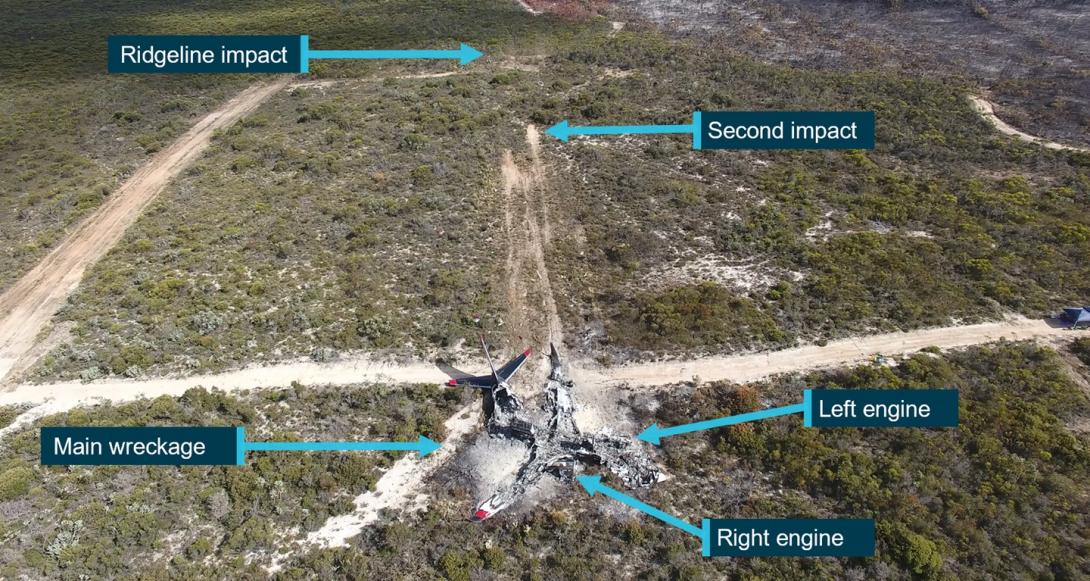
Minimum safe drop heights are in development for large firefighting aircraft in Australia, to address safety issues identified by an ATSB investigation into a 737 air tanker accident in south-west WA.
‘Bomber 139’, a Boeing 737 aircraft converted as a large air tanker, impacted a ridgeline after completing a drop while extending a fire retardant containment line during a bushfire-fighting task in the Fitzgerald River National Park on 6 February 2023.
After striking the ridgeline, the aircraft cleared a small line of foliage before impacting the ground a second time and then sliding to rest. The two pilots on board were able to evacuate through a cockpit window before the aircraft was consumed by a post-impact fire.
“The ATSB’s investigation found that the aircraft was conducting a drop at a low height and airspeed over descending terrain, which required the use of the idle thrust engine power setting and a high rate of descent,” ATSB Chief Commissioner Angus Mitchell said.
“Towards the end of the drop, the aircraft’s height and airspeed decayed as it approached rising terrain that had not been detected, and was not expected, by the aircraft captain.”
While the aircraft’s thrust levers had been advanced mid-way through the drop, there was insufficient time for engine power to increase to allow the aircraft to climb away and safely clear the ridgeline crossing the aircraft’s exit path.
The report notes the ridgeline had likely not been detected as the captain, who was the pilot flying, had declined a ‘Show Me’ run from the Birddog aircraft, had conducted right hand circuits (restricting their visibility of the target area as they were seated in the left seat on the flightdeck), likely had no visibility of the ridgeline during the go-around from the first drop, and was led by the Birddog to the target through smoke on the second drop.
“Not detecting the rising terrain likely contributed to the captain allowing the aircraft to enter a low energy state during the drop.”
Further, the co-pilot did not identify nor announce any deviations during the retardant drop, which could have alerted the aircraft captain to the low-energy state of the aircraft.
“Notably, the operator and tasking agency had not published a minimum drop height for large air tankers,” Mr Mitchell said.
“This resulted in the co-pilot, who did not believe there was a minimum drop height, not making any announcements about the aircraft’s low energy state prior to the collision.”
The accident occurred when the aircraft was conducting a second drop after releasing three-quarters of its retardant load on the prior run.
“The operator’s practice of the pilots recalculating, and lowering, their target drop speed after a partial load drop also contributed to the aircraft’s low energy state.”
The investigation found that neither the operator nor the relevant Western Australian Government Departments had published a drop height for large air tankers (whereas the US Forest Service has a minimum large air tanker drop height of 150 ft).
This meant that aircraft captains could exercise their own judgement for drop heights to improve accuracy.
Bomber 139 was operating in Australia under a contract with the National Aerial Firefighting Centre, which did not impose a minimum drop height, but required the operator to comply with the standard operating procedures (SOPs) of the member state for the aircraft’s nominated operational base, in this case Western Australia.
In turn the Western Australia large air tanker SOPs did not impose a minimum drop height limit.
Since the accident Coulson Aviation implemented a minimum drop height of 200 ft for its airtankers, while the Western Australian Department of Fire and Emergency Services and the Department of Biodiversity, Conservation and Attractions are amending procedures to incorporate drop heights, including a large airtanker drop height of 200 ft.
Meanwhile, at a national level, the Australasian Fire and Emergency Services Authorities Council, the parent organisation for the National Aerial Firefighting Centre, has undertaken to develop national large air tanker SOPs.
Separately, the ATSB has issued a safety recommendation to Coulson Aviation to address crew resource management procedures for retardant drops to reduce the risk of the aircraft entering an unrecoverable state before the pilot monitoring alerts the pilot flying.
“This accident highlights that standard operating procedures and crew resource management should be implemented with the intent to prevent an unsafe situation from developing,” said Mr Mitchell.
“Safety standards should not be solely dependent on the performance of the pilot flying and recovery call-outs.”
Read the final report: Controlled flight into terrain involving Boeing 737-3H4 Fireliner, N619SW, Fitzgerald River National Park, Western Australia on 6 February 2023


